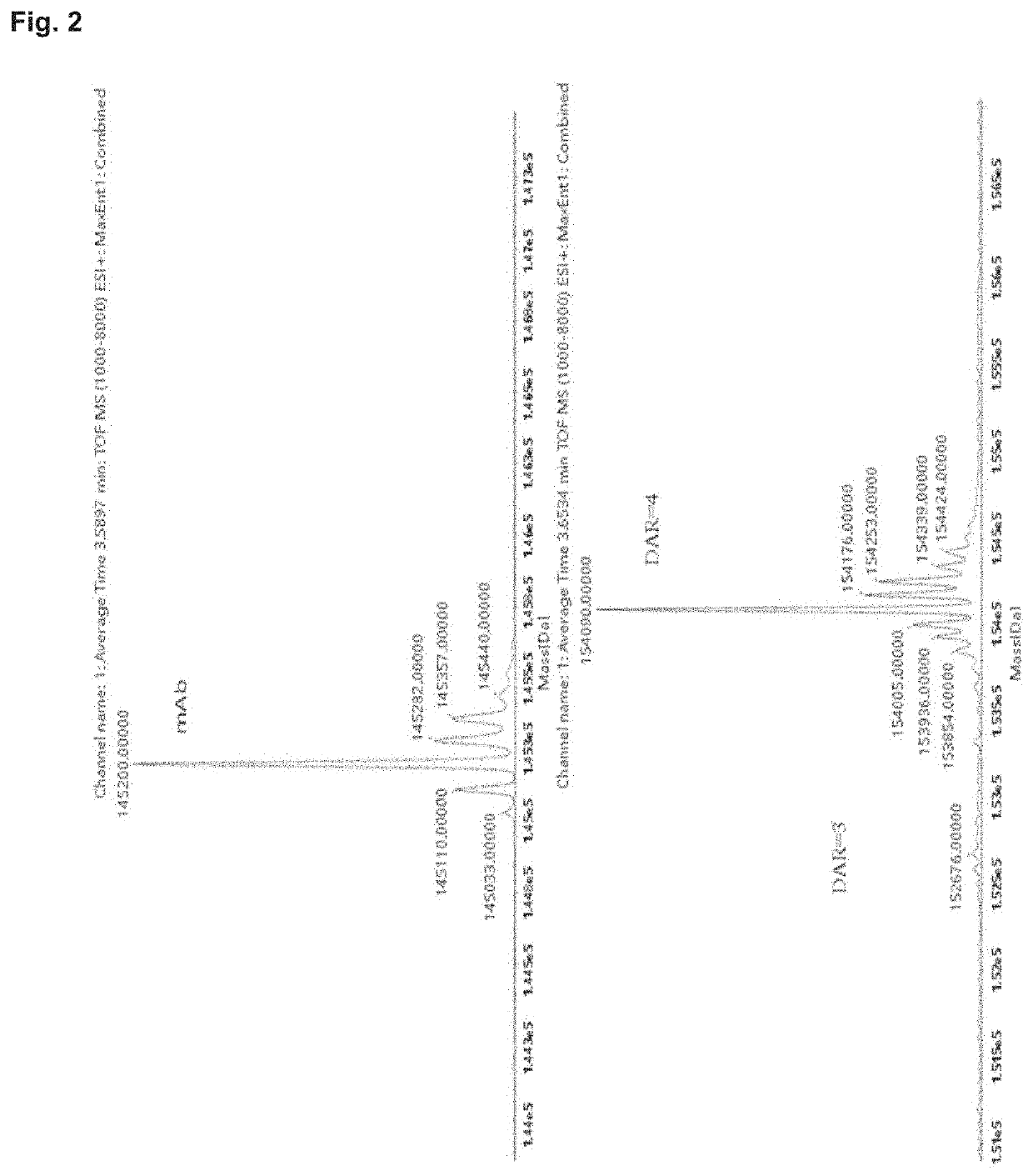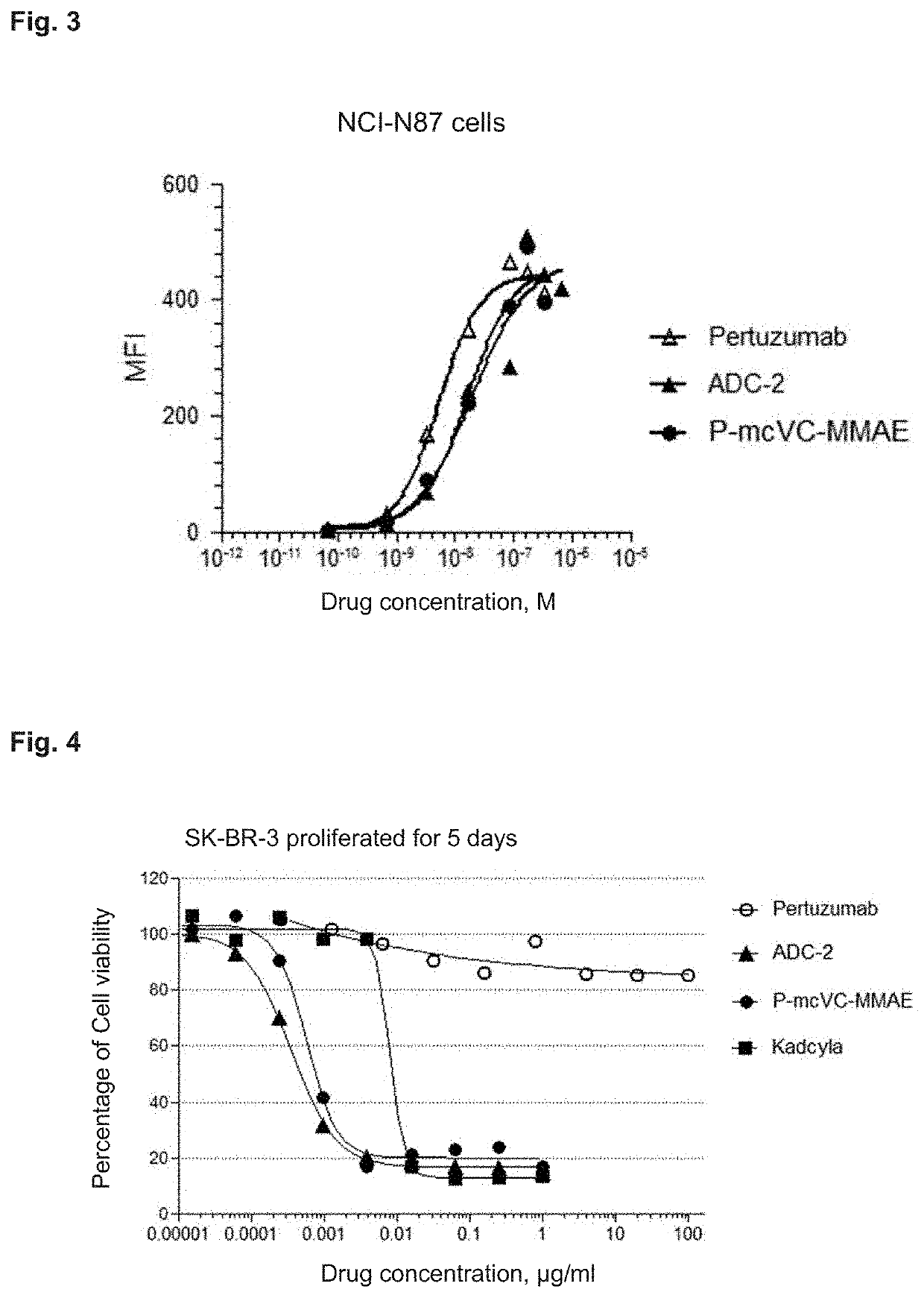Di-substituted maleic amide linker for antibody drug conjugating and preparation method and use thereof
a maleic amide and antibody technology, applied in the field of new disulfide bond bridging, macromolecules, therapeutic conjugates, can solve the problems of difficult or inefficient optimization of drug association with intracellular target, reducing the amount of systemically released cytotoxins, and many attempts to develop effective methods. , to achieve the effect of reducing the amount of systemically released cytotoxins, and strong stability
- Summary
- Abstract
- Description
- Claims
- Application Information
AI Technical Summary
Benefits of technology
Problems solved by technology
Method used
Image
Examples
example 1
on of ADC-1
[0330]A pertuzumab stock solution was diluted to 5 mg / mL with 50 mM potassium dihydrogen phosphate-sodium hydroxide (KH2PO4—NaOH) / 150 mM sodium chloride (NaCl) / 1 mM diethylene triamine pentacetate acid (DTPA) reaction buffer solution with a pH of 7.4, and then 6.0× excess molar ratio of tris(2-carboxyethyl)phosphine hydrochloride (TCEP) was added thereto. The obtained reaction solution was stirred at 35° C. for 10 hours.
[0331]Subsequently, without being purified, the reaction solution was cooled down to 8° C. and an appropriate amount of dimethyl sulfoxide (DMSO) and 6× excess molar ratio of compound G-2 (10 mg / ml, pre-dissolved in DMSO) were added thereto, and DMSO in the reaction system was ensured to be no more than 15% by volume. The obtained reaction solution was stirred at 37° C. for 3 hours for coupling.
[0332]The reaction solution after coupling reaction was purified by filtration with a desalting column using histidine-acetic acid / sucrose gel (pH 6.0), and then sa...
example 2
on of ADC-2
[0333]A pertuzumab stock solution was diluted to 5 mg / mL with 50 mM potassium dihydrogen phosphate-sodium hydroxide (KH2PO4—NaOH) / 150 mM sodium chloride (NaCl) / 1 mM diethylene triamine pentacetate acid (DTPA) reaction buffer solution with a pH of 7.4, and then 10× excess molar ratio of tris(2-carboxyethyl)phosphine hydrochloride (TCEP) was added thereto. The obtained reaction solution was stirred at 10° C. for 4 hours.
[0334]Subsequently, without being purified, the reaction solution was cooled down to 5° C. and an appropriate amount of dimethylacetamide (DMA) and 6× excess molar ratio of compound K-2 (10 mg / ml, pre-dissolved in DMA) were added thereto, and DMA in the reaction system was ensured to be no more than 10% by volume. The obtained reaction solution was stirred at 25° C. for 2.5 hours for coupling.
[0335]The reaction solution after coupling reaction was purified by filtration with a desalting column using histidine-acetic acid / sucrose gel (pH 6.0), and then sample...
example 3
on of ADC-3
[0336]A pertuzumab stock solution was diluted to 5 mg / mL with 50 mM potassium dihydrogen phosphate-sodium hydroxide (KH2PO4—NaOH) / 150 mM sodium chloride (NaCl) / 1 mM diethylene triamine pentacetate acid (DTPA) reaction buffer solution with a pH of 7.4, and then 20× excess molar ratio of tris(2-carboxyethyl)phosphine hydrochloride (TCEP) was added thereto. The obtained reaction solution was stirred at 15° C. for 2 hours.
[0337]Subsequently, without being purified, the reaction solution was cooled down to 10° C. and an appropriate amount of acetonitrile (ACN) and 6× excess molar ratio of compound K-3 (10 mg / ml, pre-dissolved in ACN) were added thereto, and ACN in the reaction system was ensured to be no more than 10% by volume. The obtained reaction solution was stirred at 10° C. for 4 hours for coupling.
[0338]The reaction solution after coupling reaction was purified by filtration with a desalting column using histidine-acetic acid / sucrose gel (pH 6.0), and then sample at ab...
PUM
| Property | Measurement | Unit |
|---|---|---|
| storage temperature | aaaaa | aaaaa |
| pore size | aaaaa | aaaaa |
| transparent | aaaaa | aaaaa |
Abstract
Description
Claims
Application Information
 Login to View More
Login to View More - R&D
- Intellectual Property
- Life Sciences
- Materials
- Tech Scout
- Unparalleled Data Quality
- Higher Quality Content
- 60% Fewer Hallucinations
Browse by: Latest US Patents, China's latest patents, Technical Efficacy Thesaurus, Application Domain, Technology Topic, Popular Technical Reports.
© 2025 PatSnap. All rights reserved.Legal|Privacy policy|Modern Slavery Act Transparency Statement|Sitemap|About US| Contact US: help@patsnap.com



